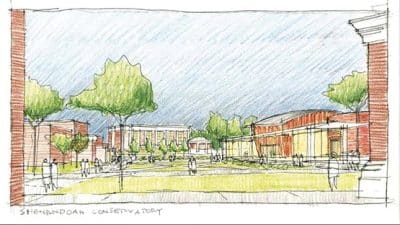The Top Story by Chris Graham
The Shenandoah Valley is the place to be – and Staunton mayor John Avoli couldn’t be any happier that this is now the case.
“This is one of the things that the city has been working toward building. The fact is that we have been losing population in recent years, and that’s something that we’ve needed to address as a community,” Avoli told The Augusta Free Press.
More than 2,000 new housing units have been approved in the Queen City this year to date. Those numbers are in line with the pace of residential development activity that is being seen in other localities in the Valley – where it seems that builders can’t put up homes fast enough to meet consumer demand.
“The past two or three years, the market has been as strong as I have ever seen it,” said Nancy Hall, the president of the Greater Augusta Association of Realtors.Hall told the AFP that the driving force to the uptick in the local housing market is the influx of people from outside the Shenandoah Valley who have been attracted to the region by the availability of affordable housing and the generally low tax rates that are in place here.
“Houses stay on the market for a short period of time. If they’re priced right, they’ll go in almost no time. Demand is that strong,” Hall said.
The population surge that will accompany the increased demand for housing will help Staunton rebuild its tax base, Avoli said.
“At the same time, we’re cognizant of the fact that we need to make sure that our growth is controlled growth. The planning commission and city council are both working to make sure that that’s the case here in Staunton,” Avoli said.
Making sure that growth is controlled is an issue for leaders in neighboring Augusta County as well.
“We want to make sure that we put growth in the right places,” said Nancy Sorrells, who represents the predominantly rural Riverheads District on the Augusta County Board of Supervisors and is serving as the chair of the committee in charge of reviewing the county’s comprehensive plan.
“At this stage, we’re still trying to get a handle on how we want to grow, and where we want to grow. We don’t want to stop growth. We just want to make sure that the growth that we experience enhances what Augusta County already is. So deciding where we want to grow and how fast we want to grow is an important point of focus for us right now,” Sorrells told the AFP.
The focus in Augusta County is on making sure that growth occurs in areas where there is infrastructure in place – like roads and public schools – to accommodate the influx of people and vehicles that comes with growth.
There is a similar push to manage growth in Rockingham County.
“People will still come. Companies will still come. But we can make the problem a lot worse based on the policies that we follow,” said Kim Sandum, the president of the Rockingham County-based Community Alliance for Preservation, which has been leading the local effort to find alternatives to the construction of a highway bypass that would bisect the southern and eastern parts of the county.
“One of our main concerns is once you put a road out into an area, you’ve opened up access for that area. So it makes it easier to live farther away from your job or your shopping or whatever you’re on your way to doing. That ends up moving people into areas that were previously unpopulated. That’s what we call sprawl,” Sandum told the AFP.
“What we see is people trying to build roads to build their way out of congestion, but oftentimes you end up building your way into an additional problem,” Sandum said.
“We can have a very nice piece of road, but at the end of the road, you end up with additional problems,” Sandum said.
Officials in Waynesboro are working through similar issues – with residential and commercial development both booming in the River City at the present time.
“At the time of our last comprehensive-plan revision, in 1997 and 1998, a lot of our focus was on neighborhood preservation and community preservation,” city planner Jim Shaw told the AFP.
“But now, with the pace of development that we’re seeing, the focus is on growth management,” Shaw said of Waynesboro’s ongoing review of its comprehensive plan.
“The planning commission and city council agendas are filled with new development issues. To a great extent, that’s where the resources of the city are going. Just managing the number of applications that come in on a daily and weekly basis is challenging,” Shaw said.
The bigger challenge might be fighting the urge to throw up a big stop sign.
“The Valley is a desirable place to live, and it’s an affordable place to live. People are able to sell their homes in other localities and other states and make a profit and come here and live our slice of life and have some money in the bank. The challenge that we face is finding a way to be able to embrace them instead of treating them as if they are part of the problem,” Sorrells said.
(Originally published 12-19-05)










